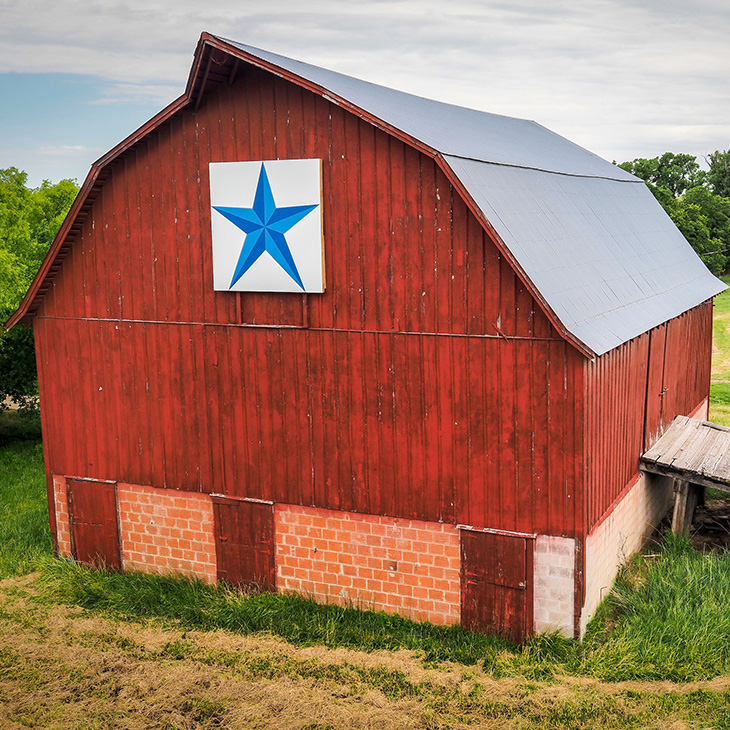
Barn quilts brighten up the rural countryside
Friday, September 28, 2018
There’s nothing better than snuggling under a warm quilt to read a good book or take a nap on a cool afternoon. However, not all quilts are good for relaxing on the couch. While a barn quilt won’t keep you warm in the cool weather, it certainly has the ability to brighten up the rural countryside.
Barn quilts obviously aren’t quilts at all – rather they are paintings of quilt blocks. Originally, the barn quilts were painted directly on the surface of the barn. Today, however, they’re quilt block designs painted on wood and hung on barns. A full-size barn quilt is 8 feet by 8 feet, so coupled with bright colors, they easily are visible on the barns. Although extremely popular in the eastern part of the country, barn quilts are just starting to make a showing in Oklahoma.
Barn quilts originated in the late 1980s when Donna Sue Groves, along with her mother, Maxine, bought a farm in Adams County, Ohio. The property had a small, rather plain tobacco barn on it, and Groves got the idea to have a quilt block painted on it to honor her mother, who was a master quilter. It also was a way to show pride in their Appalachian heritage. After talking with friends and neighbors, Groves realized the project had wide appeal and could be beneficial to the community. The Adams County trail was completed in 2003 and features 20 quilt patterns found on a typical sampler.
Lynda Latta, Oklahoma State University Cooperative Extension county director in Ellis County, said she became interested in barn quilts while traveling to a national family and consumer sciences meeting in West Virginia a few years ago.
“This is where I first learned about barn quilts and discovered a barn quilt trail. They were majestic on the wonderful old barns,” Latta said. “Seeing them inspired me to bring barn quilts to Oklahoma. Even though we are limited on large, historic barns, these barn quilts can be placed on any outbuilding and the same beauty is still there.”
After returning home, Latta said she dove into learning about barn quilt trails and did research for barn quilts in Oklahoma. Unfortunately, she said she found no information for the state, but did learn Suzi Parron was the first person to document barn quilts in a book. And, as luck would have it, Parron was teaching a workshop in Oklahoma City.
Latta encouraged some coworkers to attend the workshop, and from there, an idea was born.
“That’s when I realized we must get Oklahoma on the barn quilt map. With help from OSU Cooperative Extension educators in Woodward and Dewey counties, and retired educator Recia Garcia, we hit the ground running.”
Latta, along with Woodward County OSU Cooperative Extension educator Rhonda DeVor, traveled to Kansas to visit a trail and learn from groups and individuals how to get started organizing a trail. A barn quilt trail is a collection of quilt blocks mounted on location that make a driving or walking tour possible. Then they started teaching painting classes and got the first trail started. They arranged for Parron to come to Northwest Oklahoma in October last year for a three-day event and share her expertise.
“Suzi was very impressed with how far we’d come in such a short time,” Latta said. “In the last year I’ve taught workshops in the northwest part of the state. People from Kansas, Texas and New Mexico have attended. I’ve also done workshops at State 4-H Roundup, school enrichment with third and fourth graders, county 4-H workshops, as well as two days of workshops with Suzi Parron. In all I’d estimate more than 575 people have attended and learned about the art and fun of painting barn quilts. I’ve got more workshops planned, too.”
The Oklahoma Quilt Trail does not limit quilt designs to a specific pattern. Latta said people who want to participate are encouraged to paint different quilt blocks using traditional geometric designs. However, some states do require the barn quilt blocks be made from an original quilt owned by the family.
There are thousands of existing patterns available and sometimes a pattern is chosen for its name. For example, the pattern may be corn and beans or hens and chicks to signify what is grown on that particular farm. In some cases, a quilt block is a tribute to a lost loved one; a floral pattern could depict the land owner’s love of gardening; a design in a red, white and blue motif could demonstrate patriotism; or the family’s initials can be incorporated in the center of the block to create a unique barn quilt.
“I’m so excited about this project, and as an Extension educator I have been able to educate numerous groups and individuals about barn quilts,” Latta said.
Currently, a website is being developed that will feature a map of the quilt trails available in Oklahoma. There also is a Facebook page for the quilt trail project.
“It’s my passion to see Oklahoma showcase our history of quilting and become a destination for travelers. There are research-based evaluations showing the economic impact of barn quilt trails and that’s my plan for the future of this project,” Latta said. “I want to pull visitors into our small towns to experience the trails, eat in our restaurants and shop in our local businesses. This could definitely be a boost for our state.”
For more information about upcoming painting workshops, contact Latta at 580-885-7775 or lynda.latta@okstate.edu.
Story by Trisha Gedon
